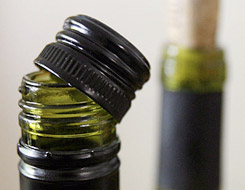The Last Corkscrew
I was on Lindsey Gustin’s cooking show on Channel 10 in Fairfax (public access) yesterday (http://geocities.com/chefsrecipes/index.html) when I noticed that out of the 9 bottles of wine I brought on the show, 3 had screwtops also known as Stelvin closures. Over at www.tastedc.com where I organize my many wine classes like the popular “Wine Basics 101” and also the exciting “Introduction to the Wines of Italy: Wines of Sicily and the South” on Thursday, December 4th, I often notice that the wines being served have changed from cork to screwtop. For awhile, this was mostly Sauvignon Blancs from New Zealand, but I’m even seeing German Rieslings and the Shiraz from Australia had Stelvins too!
I’ve read alot about the cork vs. screwtop controversy (you can add in plastic corks too) and George Taber wrote a whole book on it “To Cork or Not to Cork” http://www.amazon.com/Cork-Not-Tradition-Romance-Science/dp/0743299345 which really covered the topic in depth. In a nutshell, cork comes from the bark of a tree primarily grown in Portugal and Spain. It’s a renewable resource, every 10 years bark is taken from the same trees and they continue to live and give cork bark for maybe around 200 years. The problem is with the world demand for cork for wine, the cork industry has a tough time “curing” the cork so that it is free of offending organisms. Something like 3% to 8% of all wines sold have a TCA problem also known as 2,4,6 trichlooanisole or cork taint. The offensive odor can be noticed in very small amounts in solution, it has a very mildewy wet cardboard aroma.
So if you manufactured a product and sold it to the public, but 1 out of 20 was defective, would you consider this an acceptable fault rate? Probably not, but it is a reality. And the solution seems to be just a better closure – and screwtops have been used successfully in many consumer applications and have worked very well. A few other points to mention:
- corks break and seep air; screwtops really do not,
- if you store wines for more than a few months, you need to lay them down horizontally if they have a cork because if the cork grows dry, it will seep in air; Screwtop wines are perfectly fine standing them up in storage,
- corks are hard to get out and need some type of corkscrew; Screwtops you simply twist,
- corks can be hard to get back into the bottle or you need to find another closure device; Screwtops screw right back on,
- corks rely on agricultural resources; screwtops are an industrial product.
The last point has caused some controversy–The World Wildlife Fund put together a PR release to protect certain animals that might lose their cork tree forest if demand for cork significantly changes because of new technology..but need I say more? Kind of ridiculous on so many fronts–sure I want to protect the natural habitat, but the cork industry is just that, a business, and there are other ways to get businesses and people to be socially responsible–don’t force them to accept a 1 in 20 defective rate to save birds!!
Whooops, almost forgot, I had lunch today at Agraria in Georgetown and purchased a relatively expensive Pinot Noir from Oregon (Maysara) and yes, you guessed it, it had a screwtop!
I’ll cover more on cork and screwtops in the near future, and I will also cover the plastic closure – seems many TasteDC’s wine class attendees like the idea of some kind of cork being presented when they sit down to eat in a restaurant, I guess the breaking of the metal and offering of a screwtop just doesn’t cut it for them; but what will they do when box wines become better and more popular?
Charlie “I Drink On the Job” Adler






